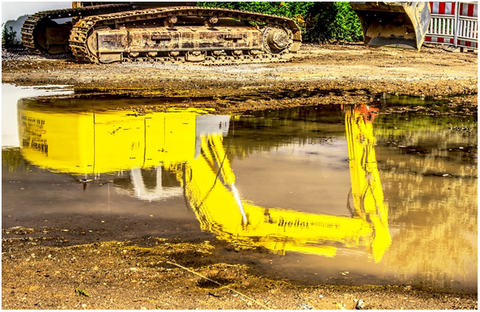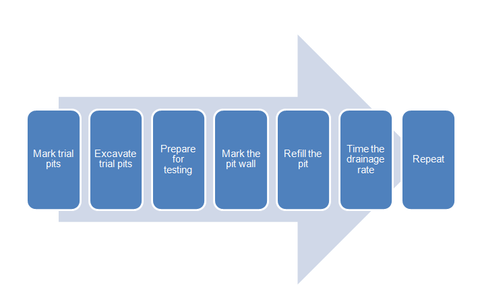What is a percolation (Infiltration) test for soakaway attenuation storage?

If you require an Infiltration test to BRE365 in the Greater Manchester area please get in touch.
What is a percolation test?
The percolation test also known as the infiltration or soakaway test is perfomed out by a drainage engineer to determine whether a soakaway is suitable in any given location. The test will also ultimatley yield the Infiltration rate which is used to size a soakaway Percolation tests are very important, particularly on new building projects, they will give an immediate indication of the water table and drainage rates of any given area, thus allowing a decision to made on the overall viability of the soakaway.

How is a percolation test carried out?
The actual percolation test itself is quite a simple one devised to measure how quickly water drains away from the soil. This is achieved by digging a pit, the size of which can vary according to the site. Once dug the pit can be filled with water and allowed to drain naturally. The drainage speed and height should be recorded at regular intervals in order to produce the most accurate results.
The method for carrying out a percolation test is as follows.
- Mark trial Pits: As a minimum two trial pits are required in the area that the soakaway is likely to be installed in. The dimensions of these pits should be at least 0.3m x 1.0m in plan and 1.2m deep.
- Excavate the trial pits: The pits should be excavated to the dimensions above and should be at least 30cm deeper than any proposed soakaway will be; if this is not yet known adopting a depth of 1.5m is standard practice. The hole should be rectangular in shape and all sides should be cleanly squared off. If the water table is reached during this initial excavation a soakaway will not be a suitable option of that particular site.
- Prepare for testing: Prior to a timed test being performed the pits should be completely filled with water and allowed to drain for a period of 24 hours. If water remains in the test pit after 24 hours a soakaway will not be a suitable option of that particular site.
- Mark the pit wall: Depths of 75% and 25% of the total depth should be clearly marked on the pit wall prior to performing a timed test.
- Refill the pit: Once the markings are in place the pit should be completely filled again, as quickly as possible.
- Time the drainage rate: Use a stopwatch to record how quickly the water drains past both the 75% and the 25% markers.
- Repeat: Once the water has completely drained the test should be repeated at least three times on at least two separate pits.

Why carry out a percolation test?
When commencing a build where stormwater storage is required it is prudent that a percolation test is carried out. It is usually required under local authority regulations and will provide the construction team with accurate data with regards to the state of the surrounding land. Even if you supply your local authority with all of the information detailed above it is not uncommon for them to request further test until they are completely satisfied.
If you require an Infiltration test to BRE365 in the Greater Manchester area please get in touch.
- Jack Cairney
Comments 0